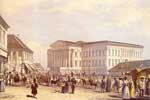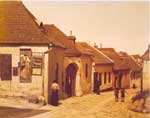|
 The country was desolate: Petőfi had been killed fighting, Kossuth had fled to Turkey and Count Lajos Batthyány, Prime Minister in Hungary's first independent government, faced the firing squad. It was only in 1867 that the wily old politician Ferenc Deák effected the so-called Compromise between the Habsburgs and the Hungarians. This allowed Hungary its own domestic government, but meant that foreign and military affairs were voted on jointly with Vienna. Under the system known as the Dual Monarchy, Emperor Franz Joseph was to remain Emperor in Austria, while in Hungary he was crowned King. The Compromise Agreement effectively opened up the towns of Buda and Pest to foreign capital, and also opened the Austrian empire to Hungarian grain from the Great Plain, some of the most fertile arable land in Europe. The resulting explosion of wealth turned what had been two provincial little settlements on the banks of the Danube into a thrusting boomtown. The country was desolate: Petőfi had been killed fighting, Kossuth had fled to Turkey and Count Lajos Batthyány, Prime Minister in Hungary's first independent government, faced the firing squad. It was only in 1867 that the wily old politician Ferenc Deák effected the so-called Compromise between the Habsburgs and the Hungarians. This allowed Hungary its own domestic government, but meant that foreign and military affairs were voted on jointly with Vienna. Under the system known as the Dual Monarchy, Emperor Franz Joseph was to remain Emperor in Austria, while in Hungary he was crowned King. The Compromise Agreement effectively opened up the towns of Buda and Pest to foreign capital, and also opened the Austrian empire to Hungarian grain from the Great Plain, some of the most fertile arable land in Europe. The resulting explosion of wealth turned what had been two provincial little settlements on the banks of the Danube into a thrusting boomtown.
|
 In 1873 Buda and Pest finally united to form a single capital city. After this came a period of rebuilding on a massive scale. Almost the whole of Pest was tom down, and its shabby, squat little buildings were replaced with glittering palaces and wide, tree-lined boulevards. Once described as the biggest village in Europe, the remodelled city now had to be seen to be believed. People started comparing it with Paris. In 1896 Budapest celebrated its “Millennium” 1,000 years since the Magyar tribes first streamed into the Carpathian basin around 896. In 1873 Buda and Pest finally united to form a single capital city. After this came a period of rebuilding on a massive scale. Almost the whole of Pest was tom down, and its shabby, squat little buildings were replaced with glittering palaces and wide, tree-lined boulevards. Once described as the biggest village in Europe, the remodelled city now had to be seen to be believed. People started comparing it with Paris. In 1896 Budapest celebrated its “Millennium” 1,000 years since the Magyar tribes first streamed into the Carpathian basin around 896. |
|
|